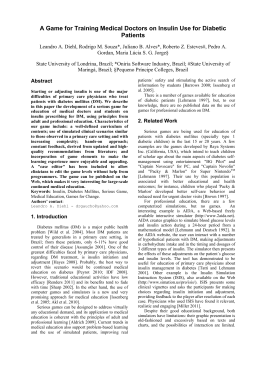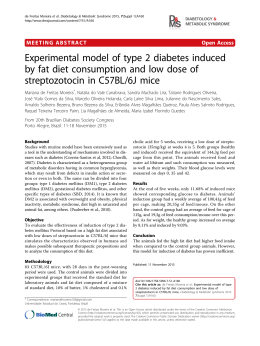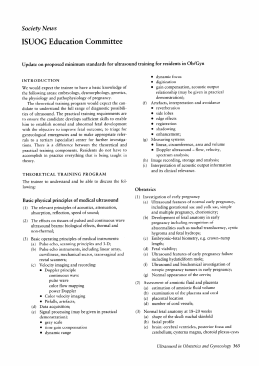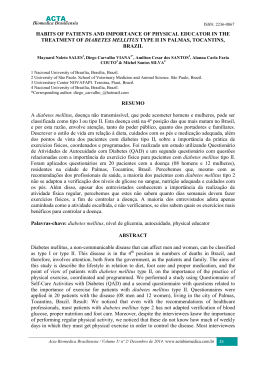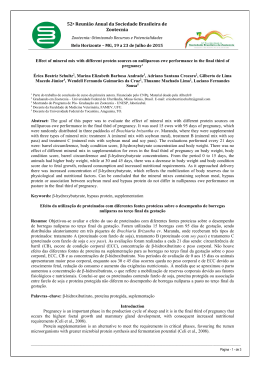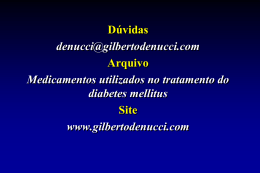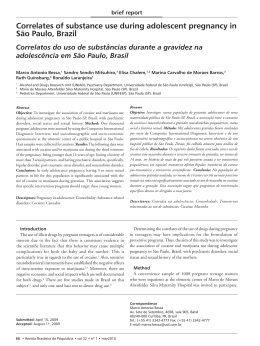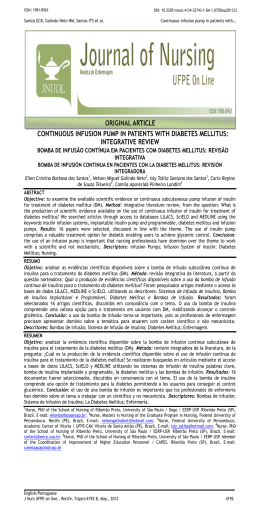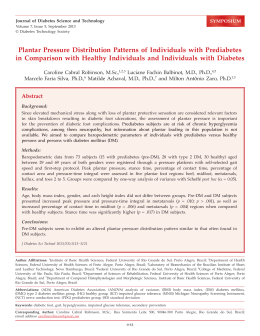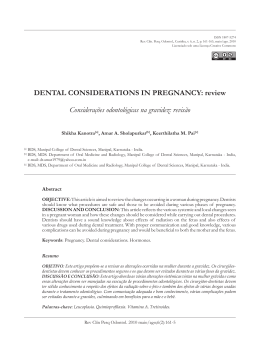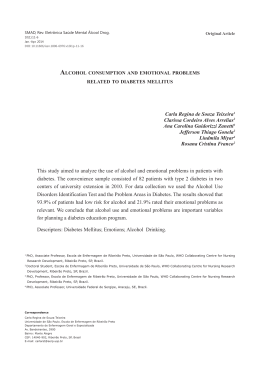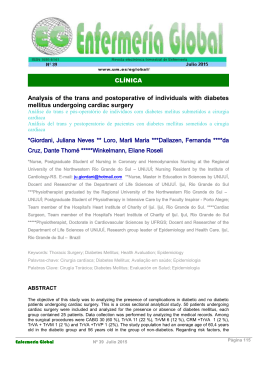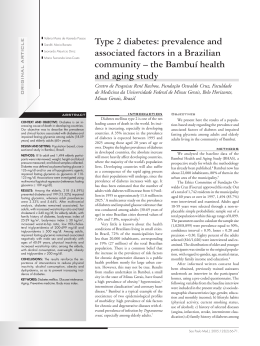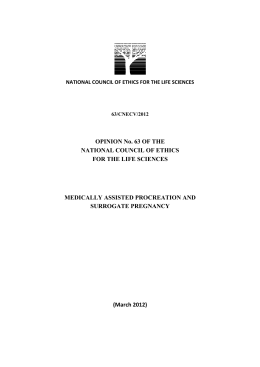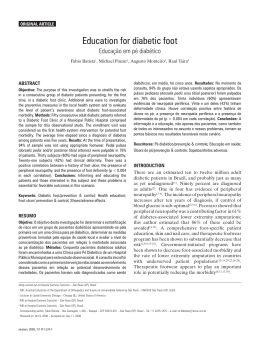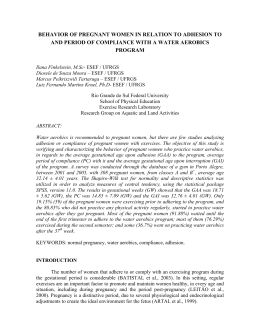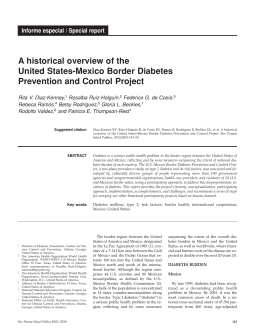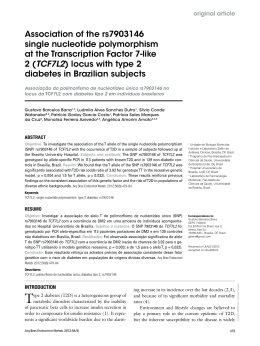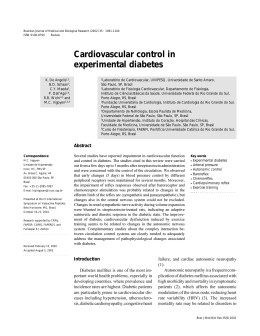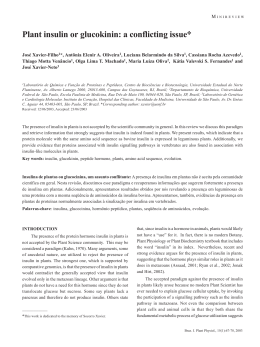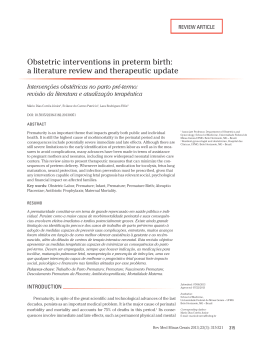Acta Obstet Ginecol Port 2008;2(3):143-145 Caso Clínico/Case Report Insulin dependent diabetes mellitus presenting as diabetic ketoacidosis during pregnancy Diabetes Mellitus insulinodependente que se manifesta como cetoacidose diabética durante a gravidez Ana Luísa Areia*, Elvira Marta**, Paulo Moura*** Maternidade Daniel de Matos, Hospitais da Universidade de Coimbra Abstract Type 1 diabetes mellitus seldom presents in the form of diabetic ketoacidosis during pregnancy. We report a case of a 20-year-old woman, presenting at 32 weeks gestation with hyperglycemia, heavy glycosuria and ketonuria. The unstable maternal condition together with a non-reassuring fetal status and unfavorable cervix led to the performance of a cesarean section. One year of follow-up confirmed the diagnosis of type 1 diabetes mellitus. Obstetricians should be aware that pregnant women presenting with hyperglycemic symptoms need appropriate evaluation in order to rule out type1 diabetes mellitus. If this diagnosis is made, immediate treatment is required to prevent the high maternal and fetal morbidity associated with diabetic ketoacidosis. Key words: Type 1 Diabetes; Pregnancy; Ketoacidosis Introduction If a diagnosis of diabetes is made in pregnancy, it is gestational diabetes. In this condition there is insulin resistance and insulin is insufficient to maintain a normal glucose value but usually it is enough to prevent ketoacidosis episodes. Diabetic ketoacidosis as a form of appearance of type 1 diabetes in pregnancy is very rare. We report one such case. * Interna Complementar de Ginecologia / Obstetrícia ** Assistente Hospitalar Graduada de Obstetrícia *** Professor Auxiliar de Obstetrícia da Faculdade de Medicina da Universidade de Coimbra. Director de Serviço de Obstetrícia da Maternidade Daniel de Matos. Case A 20-year-old Caucasian European woman was admitted in our department at 32 weeks gestation with preterm labour; she reported diminished fetal movements for the past 24 hours. There was neither past nor family history of diabetes mellitus or risk factor for developing gestational diabetes mellitus (GDM). She had been diagnosed with Crohn’s disease six years previously, but she had needed no medication during pregnancy. Previous antenatal progress in our hospital was unremarkable with a normal 50 g glucose challenge test carried out at the 28th week. At the most recent checkup, 15 days before admission, glycosuria was absent. 143 Areia AL, Marta E, Moura P On admission she was hyperventilating and ketotic. Her pulse was 80 beats/minute and her supine blood pressure was 120/80 mmHg. Heavy glycosuria and ketonuria were present. Random plasma glucose revealed a value of 618 mg/dl, with other biochemical parameters normal. Further history revealed that she had been having increased thirst and polyuria during the previous month, whose significance she failed to appreciate. The non-stress-test was non-reassuring and demonstrated regular contractions. Ultrasound scan showed a fetus without malformations, with abdominal circumference above the 90th percentile (LGA baby) and a normal biophysical profile. Tocolytic and corticoid therapy were initiated and intravenous insulin infusion was started. Re-hydratation and electrolyte supplementation were administered. Despite continuous intravenous insulin infusion, plasma glucose values remained between 494 and 569 mg/dl. Twenty four hours after admission, a non-stress test revealed null variability and fetal ultrasound found oedema of subcutaneous tissue and absence of fetal respiratory movements. Umbilical artery doppler was still normal. Combining the severity of the mother’s condition with the non-reassuring fetal well-being and the unfavorable cervical score, a cesarean section was performed. A healthy 2410 g female infant was born who had no hypoglycemia episodes. Supplementary investigation revealed that serum insulin was zero; islet cells antibodies (ICA) were undetectable at that time, with positive values for antibodies to glutamate decarboxylase (anti-GAD) and IA2 antibodies. Glycosylated hemoglobin (HbA1c) was 10 %. In the puerperium, she continued with insulin therapy. Complementary results at that time revealed ICA positivity. And so on day three, a regimen of insulin treatment was started with the diagnosis of new onset insulin dependent diabetes mellitus. The patient is monitored in our institution, with good glycemic control under intensive insulin therapy (intermediate and ultra-fast insulin) 12 months after that ketoacidosis episode. 144 Comment The literature reports some cases of type 1 diabetes mellitus (DM) developing during pregnancy, but those with ketoacidosis are scarce. Diabetes first appearing during pregnancy is classified as gestational DM, a self-limiting disorder that usually terminates when pregnancy ends1. But type 1 DM commonly presents as a new diagnosis during the teenage years2. Diabetic ketoacidosis (DKA) in pregnancy, although rare, is a possible complication in both women with GDM and pregnant women with preexisting DM1. Newly-developing type 1 DM first presenting in pregnancy as DKA has only been reported in the literature eight times (reported in 15 cases). DKA is associated with high fetal morbimortality (up to 90%), probably due to low placental blood flow during maternal hypovolemia2. It is known that pregnancy is a state of immunosuppression (3). Type 1 DM can be seen as an organ specific autoimmune phenomena that rarely presents as DKA during pregnancy because of that immunosuppressor effect. But DKA episodes could occur in the 3rd trimester owing to the loss of that effect in late pregnancy3. The genesis of rapid-onset islet-cell failure and resultant diabetes remains a controversial topic. Research suggests that the genesis may be related to recent viral infection and that susceptibility to the diabetogenic effects of a virus may be genetic. Certain viral strains seem to have a special tropism for beta cells. Furthermore, toxins such as lead have been implicated in rapid-onset diabetes4. Our case had no history of either. Our patient showed normal progress at her antenatal visits, but the elevated HbA1c concentration at presentation suggests that she was hyperglycemic for a few months before presenting with DKA. So, even though some authors argue that the 50g glucose challenge test can prevent DKA episodes1, our case was not an example. The pregnant woman exhibited symptoms of diabetes and hyperglycemia one month before presenting with DKA although she had a nega- Acta Obstet Ginecol Port 2008;2(3):143-145 tive test for diabetes. Once she developed symptoms of hyperglycemia, the time lapse to ketoacidosis was brief. She was proven to have type 1 DM and has remained insulin dependent since then. Pregnancy can predispose a patient to ketoacidosis in several ways. In the fasting state, the increased use of glucose by both the fetus and maternal units can lead to conversion to a catabolic metabolism. Moreover, the production of diabetogenic hormones (human placental lactogen, prolactin and cortisol) during pregnancy predisposes to DKA4. During pregnancy, conditions such as infection, β-sympathomimetic therapy and labour can increase endogenous catecholamine release, thereby contributing to the onset of DKA4. Some authors argue that ICA are predictors of type1 DM and that the stress of the third trimester of pregnancy could make the insulin deficiency manifest itself earlier than if the woman had not become pregnant2. Other authors consider that, besides being a diabetogenic condition itself, pregnancy may be an environmental factor that precipitates type 1 DM in susceptible patients5. Moreover, the presence of GAD when type 1 DM is diagnosed suggests a more rapid progression towards rapid islet β cell destruction5. Our experience should alert obstetricians to the fact that when a pregnant woman presents with hyperglycemic symptoms, type1 DM should be ruled out and immediately treated to prevent the high maternal and fetal morbidity associated with DKA. References 1. 2. 3. 4. 5. Robertson G, Wheatley T, Robinson RE. Ketoacidosis in pregnancy: an unusual presentation of diabetes mellitus. Case reports. Br J Obstet Gynaecol 1986; 93(10):1088-90. Sills IN, Rapaport R. New-onset IDDM presenting with diabetic ketoacidosis in a pregnant adolescent. Diabetes Care 1994; 17(8):904-5. Ko GT, Chow CC, Li CY, Yeung VT, Cockram CS. Insulin-dependent diabetes mellitus presenting as diabetic ketoacidosis in pregnancy. Aust N Z J Obstet Gynaecol 1995;35(3):321-2. O’Shaughnessy MJ, Beingesser KR, Khieu WU. Diabetic ketoacidosis in pregnancy with a recent normal screening test. West J Med 1999; 170(2):115-8. Quatraro A, Consoli G, Magno M, Ceriello A, Giuliano D. Pregnancy as environmental factor precipitating IDDM. Diabetes Care 1989; 12(6):438-40. 145
Download
